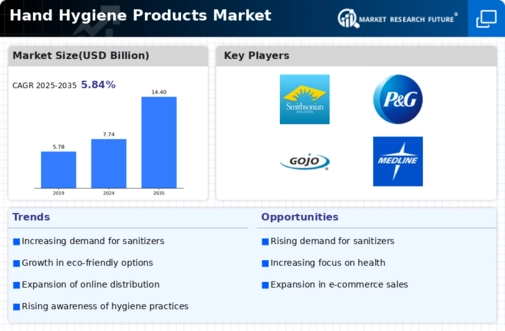Hand Hygiene Products Size
Hand Hygiene Products Market Growth Projections and Opportunities
The market dynamics of hand hygiene products are influenced by a variety of factors that reflect both consumer behavior and industry trends. At the core of this market lies the increasing awareness of the importance of hand hygiene in preventing the spread of illnesses and diseases. Hand hygiene products, including hand sanitizers, hand soaps, and hand wipes, have become essential items in households, healthcare facilities, and public spaces, driving consistent demand for these products.
One of the primary drivers of the hand hygiene products market is the growing emphasis on health and cleanliness, especially in light of recent global health crises such as the COVID-19 pandemic. Consumers are increasingly conscious of the need to maintain proper hand hygiene to protect themselves and others from infectious diseases. This heightened awareness has led to a surge in demand for hand sanitizers and other hand hygiene products, both for personal use and in institutional settings.
Furthermore, demographic trends such as urbanization and changing lifestyles contribute to the expansion of the hand hygiene products market. Urban populations, characterized by busy schedules and higher exposure to crowded environments, are more inclined towards convenient hygiene solutions. Hand sanitizers, in particular, offer a quick and portable way to disinfect hands on-the-go, catering to the needs of busy urbanites. Additionally, the rise of dual-income households and a growing aging population further drive demand for products that promote health and well-being.
Product innovation and formulation advancements play a significant role in shaping market dynamics within the hand hygiene products industry. Manufacturers are continuously developing new formulations and delivery mechanisms to enhance the efficacy and user experience of hand sanitizers and hand soaps. From alcohol-based sanitizers with moisturizing agents to foaming hand soaps with antibacterial properties, the market offers a diverse range of options to meet consumer preferences and needs. This constant innovation not only drives product differentiation but also fosters brand loyalty as consumers seek out products with specific features and benefits.
Moreover, the influence of regulatory standards and guidelines on market dynamics cannot be overlooked in the hand hygiene products industry. Regulatory bodies set standards for ingredient safety, product labeling, and efficacy testing to ensure that hand hygiene products meet quality and performance requirements. Manufacturers must adhere to these regulations to gain market access and consumer trust. Additionally, during public health emergencies, regulatory agencies may implement temporary measures or expedited approvals to meet the increased demand for hand hygiene products.
However, alongside the growth drivers, the hand hygiene products market also faces certain challenges that impact its dynamics. One such challenge is the issue of accessibility and affordability, particularly in low-income and underserved communities. While hand hygiene products are widely available in developed regions, access may be limited in rural areas or in regions with inadequate infrastructure. Furthermore, the affordability of hand hygiene products can be a barrier for economically disadvantaged individuals, leading to disparities in hygiene practices and health outcomes.
In conclusion, the hand hygiene products market is driven by factors such as health awareness, demographic trends, product innovation, and regulatory standards. While the market presents significant growth opportunities fueled by increasing consumer demand for hygiene solutions, challenges such as accessibility and affordability need to be addressed to ensure equitable access to hand hygiene products for all segments of society. Nevertheless, with continued innovation and a focus on promoting hand hygiene education, the hand hygiene products market is poised for sustained growth in the coming years.









Leave a Comment